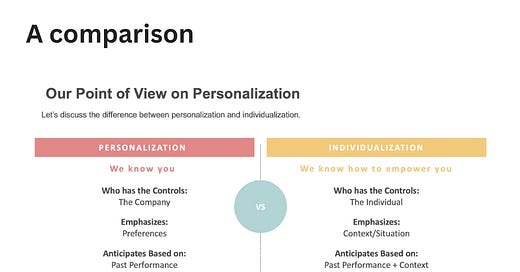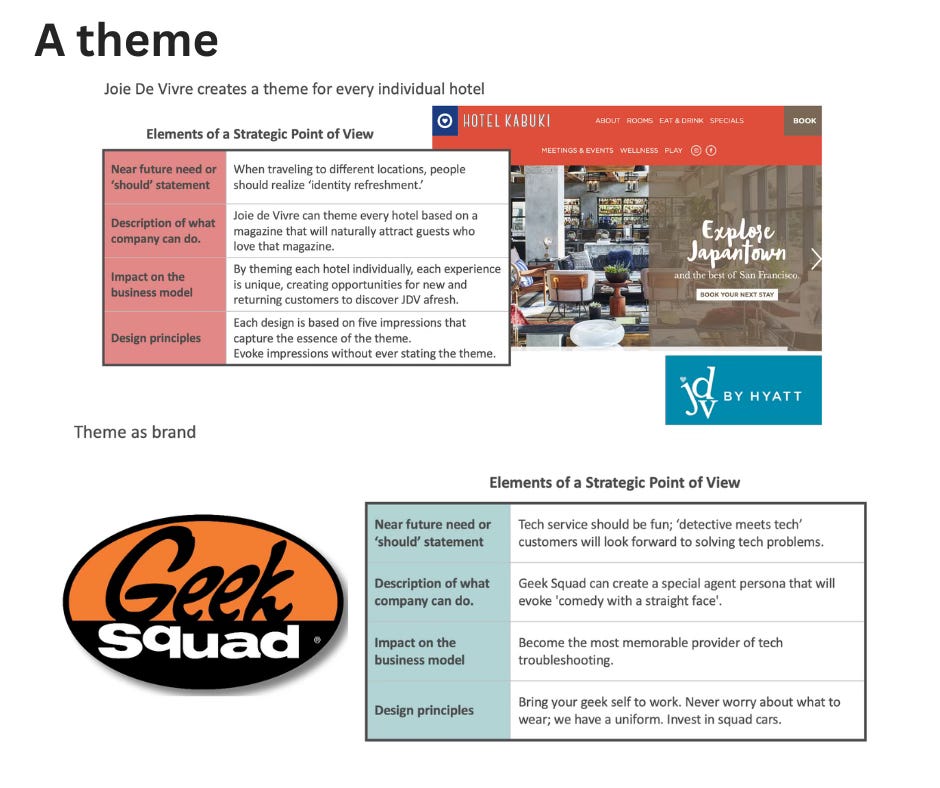Articulating the Point of View for Internal Audiences
Chapter Three: Principle 2—To Be Compelling Requires a Strategic Point of View
Dear Friends,
This is the second to last post for chapter 3. I hope you enjoy it. Please keep sharing and inviting people to subscribe!
Articulating the Point of View for Internal Audiences
While a point of view statement can be shared externally (again, see Apple on privacy), it doesn’t have to be. And certainly, the way that you share a point of view with external audiences should build your brand. So, how to share externally should be discussed in a book about brand strategy.
But in order for the point of view to become engendered to the company, the point of view statement is not enough. In fact, the point of view statement is most useful to the president of the company and other senior leaders. For the rest of the organization, there’s a need for the same elements to be presented differently.
Earlier in this chapter, I described framework making, which is essential to the presentation of insights to an organization. A strong point of view almost always is accompanied by a framework. One of the simplest frameworks to create is the comparison framework. Here’s an example from the research we conducted on personalization a few years ago.
The From/To framework provides a comparison between the old way of thinking about a problem and the new way of thinking. It’s useful for paradigm shifts. In the example above, the old paradigm is the current definition of personalization: the ability for the company to treat the customer as an individual based on their preferences and past activities. On the right side is the new paradigm, with a new name: individualization. There’s a new definition that builds on the old. “We know you” becomes “We know how to empower you.” Each important element is clarified.
From/To comparisons help organizations understand what needs to changes. And while a simple table can suffice, a graphical representation gives the framework power.
The next approach for articulating a point of view is theming. Readers of The Experience Economy will remember that Pine & Gilmore believed that theming is the most important way to articulate the desired experience. Their point of view was that the theme is the point of view.
A theme can be very helpful as a company rallies to a new objective. The theme can serve as the new brand strategy, like Geek Squad. It can help the strategist weave together key design requires, like the W hotel, whose theme is: warm, welcoming, witty, and wired. Or a theme can be used to create guidelines for very specific projects. Joie de Vivre hospitality, a Hyatt brand, creates a theme for every new, boutique hotel it creates. Themes can help employees grasp an innovation’s objectives, much like a persona might.
The final example I will share—though certainly there are many more ways—is through storytelling. You can place an insight within a historical context. My first book showed the progression of channel strategy from stores to digital context. Pine & Gilmore’s progression of economic value is a historical story framework. A story requires a narrative. A narrative needs plot, movement, familiar characters, and a hero. Story telling is a powerful way to help your employees grasp the importance of the point of view.
Here’s a true example from insights that we gathered for the 2018-2019 Collaboratives.
“Since 2015 when we discovered that there was something that comes after omnichannel strategy, we’ve been tracking the growth of context comfortables. Context comfortables are people who are comfortable sharing their data with brands they trust. Some have high context comfort. Most are comfortable. In 2018, this group makes up 52% of the US population.
“Context comfortables [the heroes] share data because they want to be empowered. And not just somewhat empowered. They use IoTs, smart phones, intelligent cars, monitors, and a wide array of other tools to help them improve their personal performance. [The narrative.] They hope that by creating their own personal ecosystems and tapping into contextual tools, they can experience something akin to ‘superpowers.’ They understand that there’s a downside to these technologies, which can be used to manipulate and control people. But they believe that the benefits far outweigh the risks. There are people who don’t like contextual solutions. We call them ‘no comfort’ consumers [the characters]. But they are a small percentage of the population. And then there’s the reluctants. They share their data reluctantly because they want the benefits of smart tools but they don’t like the potential risks.
In these two paragraphs (which have been abbreviate for, well, brevity’s sake) you can see all of the elements of storytelling. There’s the potential conflict. There’s a group that are our heroes. There’s other characters who are less important and there’s plot: the right and wrong use of data to support everyone involved. It’s also true. The story isn’t a fiction. There’s real data. The story brings the data to life.
All three of these ways of sharing the insights that drive the point of view and the direction the company should take. They do not necessarily define the whole POV. That’s what you have the point of view statement for. But they help internal audiences understand what is at stake, what’s different, and why they need to rally behind the point of view.
To be continued …
I can’t wait to share these chapters with you. I love your feedback, so please take a little time to comment on the posts!








